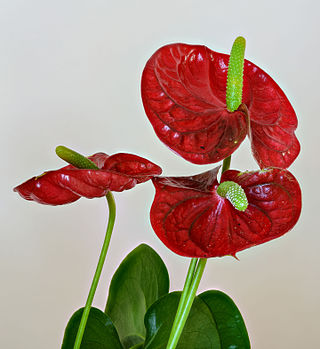
Anthurium is a genus of about 1,000 species of flowering plants, the largest genus of the arum family, Araceae. General common names include anthurium, tailflower, flamingo flower, pigtail plant, and laceleaf.

Anthurium warocqueanum, commonly known as the Queen Anthurium, is a species of plant in the genus Anthurium. Native to Colombia, it is grown in more temperate climates as a greenhouse specimen or houseplant for its ornamental foliage.
Thomas Bernard Croat is an American botanist and plant collector, noteworthy as one of botanical history's "most prolific plant collectors". He has collected and described numerous species of plants, particularly in the family Araceae, in his career at the Missouri Botanical Garden.
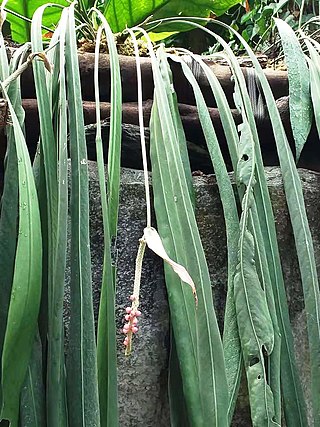
Anthurium vittariifolium is a species of flowering plant in the genus Anthurium native to the Amazon basin; southeast Colombia, Ecuador, Peru, and northern Brazil. With its long, pendulous leaves that can reach 2.4 m (8 ft), it is among those commonly known as "strap-leaved" anthuriums. It grows as an epiphyte at lower elevations of tropical moist forests, and is a member of the section Leptanthurium along with Anthurium gracile.

Anthurium regale is a species of Anthurium, a genus of flowering aroid plant in the family Araceae. It was first described by Europeans in the 1866 edition of La Belgique Horticole, where it was noted to be first collected for the houseplant trade by Gustav Wallis during his time working for Jean Jules Linden. This impressive and sought-after Anthurium species is native to Perú, where it may be found near the Huallaga River valley, to the north of Tingo María and Juanjuí, in the regions of Huánuco and San Martín, respectively. This species is found in forested areas, where it grows on trees epiphytically, ranging from sea-level environments to cloud forests, up to about 243 meters in elevation. A. regale is often found in areas where the ambient humidity is consistently high, and where temperatures remain steadily between 15 °C (59°F) and 26.6 °C (80°F).
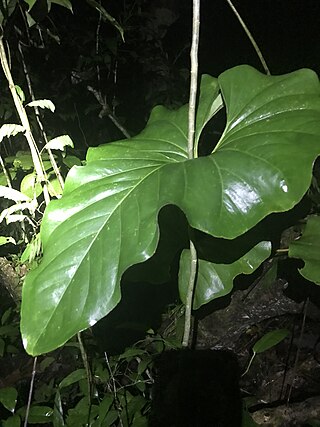
Anthurium brownii is a species of plant in the genus Anthurium native to Central and South America, from Costa Rica through Panamá, and south to Colombia, Ecuador, and Venezuela. First scientifically described in 1876, it was collected by Gustav Wallis and named for N. E. Brown. A. brownii grows from sea level up to 1,200 meters (3,900 ft) in tropical forests.

Anthurium clidemioides is a species of plant in the genus Anthurium native to Costa Rica, Panama, and Colombia. One of the more distinctive Anthuriums, it is a vining climber with almost stalkless, bullate leaves that can range from light to very dark green. Along with Anthurium flexile it is one of only two species in the genus that produces roots between nodes.

Anthurium coriaceum is a species of plant in the genus Anthurium native to southeast Brazil. A "bird's nest" type of Anthurium of the section Pachyneurium, it grows either terrestrially or epilithically in areas of seasonal dryness. It has erect leaves that feel like leather, which is where its scientific name derives from.
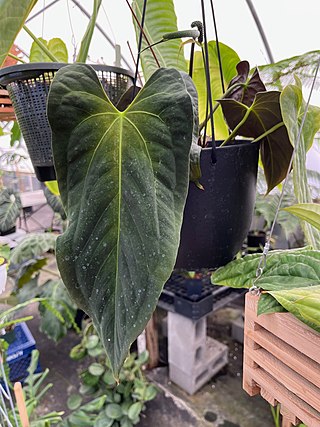
Anthurium papillilaminum is a species of plant in the genus Anthurium native to Panama. A. papillilaminum grows terrestrially and has very dark green cordate leaves on short stems. Its native range is very limited, with the species endemic to only the coasts of Colón Province and Darién Province up to 100 meters (330 ft) above sea level. A member of the section Cardiolonchium, it is closely related to other velvet-leaved Anthuriums, though it does not have silver veins on the leaves like Anthurium crystallinum.

Anthurium corrugatum is a species of plant in the genus Anthurium native to Central and South America from Panama to Ecuador. This species is noted for its cordate leaves with a network of fine veins that gives it a bullate appearance. A terrestrial grower, it is adapted to cool, humid climates. It is a member of the section Polyneurium along with Anthurium argyrostachyum and others.
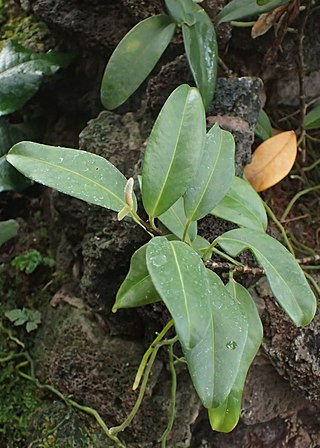
Anthurium scandens is a species of plant in the genus Anthurium. Native from Mexico to Southeast Brazil, it is the most widely distributed species of Anthurium in the Americas, and also extends to the Caribbean including Haiti, Puerto Rico, Jamaica, and other nations.

Anthurium clavigerum is a species of plant in the genus Anthurium. Native to Central and South America, it ranges from Honduras to central and western Brazil. This epiphyte has distinctive leaves that are deeply lobed and sometimes sinuous edges. The main stem can be several meters long and the palmate leaves can be 2 meters across, giving it the largest foliage of any Anthurium in Central America.

Anthurium podophyllum is a species of plant in the genus Anthurium native to coastal areas of the Mexican states of Veracruz and Oaxaca. A terrestrial species, it grows in tropical forest understories in seasonally dry areas. It is named for its palmate leaves that somewhat resemble plants in the (unrelated) genus Podophyllum, and which have many subdivisions. It is related to other terrestrial Anthurium with similar leaf morphology in the section Schizoplacium, such as Anthurium pedoradiatum, and produces orange berries.

Anthurium microspadix is a species of plant in the genus Anthurium. Growing as an epiphyte or a terrestrial shrub, it is native from the southern Mexican states of Oaxaca and Chiapas to Bolivia from 800–2,300 metres (2,600–7,500 ft) in elevation. One of the more widely distributed and variable species in its genus, it is easily confused with species such as Anthurium pallens and others.
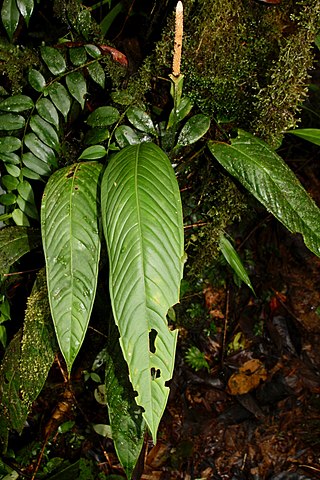
Anthurium pallens is a species of plant in the genus Anthurium. Growing as a climbing epiphyte with short stems and usually pendent growth, it is native to Central America. Easily confused with other species such as Anthurium microspadix, it can be distinguished by its typically shorter branches and leaf blades acute to rounded at the base.

Anthurium formosum is a species of plant in the genus Anthurium native to Central and South America. Epiphytic or terrestrial, it is found from Nicaragua to Colombia and northwest Venezuela.

Anthurium argyrostachyum is a species of plant in the genus Anthurium native to Ecuador and Colombia. Growing as a small shrub or an epiphyte, it is best recognized by its foliage that has triangular or arrowhead-like shape, a long central lobe, and parallel veins. It is a member of the section Polyneurium, and is thus related to Anthurium corrugatum, Anthurium panduriforme, and others that share its parallel venation and other characteristics.

Anthurium coloradense is a species of plant in the genus Anthurium native to Panama. A member of the section Polyneurium, this terrestrial shrub is most recognizable by its thin, veined leaves and its yellow-green spadix. Its foliage is very similar to other Panamanian species such as Anthurium caperatum, Anthurium santamariae and Anthurium cerrosantiagoense but may be distinguished by details such as the grooves in its stems and the pattern of veining, with the collective vein growing from the third vein in a leaf.

Anthurium obtusum is a species of plant in the genus Anthurium widely distributed in Central and South America, from Belize to Bolivia. The species was originally described as Anthurium trinerve by Adolf Engler and then in 1997, reclassified. The species is easily confused with Anthurium scandens, but can be distinguished by its terrestrial growth habit and a white spathe which stays erect rather than reflexed.
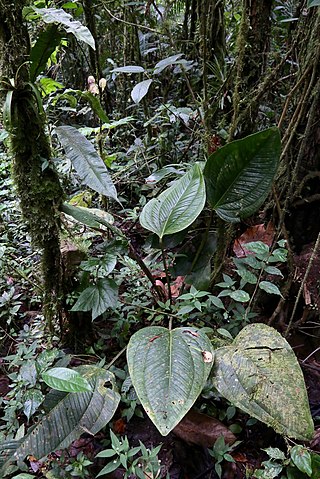
Anthurium ovatifolium is a species of plant in the genus Anthurium native to Colombia, Ecuador, and Peru. It grows in wet tropical habitats, and is a member of the section Digitinervium. Its species name refers to the oval shape of its leaves, and it can be distinguished from similar species like Anthurium lentii by its red berries.



















